The 1971 BMW 2800CS, a sleek and elegant coupe, represents a pivotal moment in the evolution of BMW’s sports car lineage. Introduced in 1968, the 2800CS built upon the success of its predecessor, the 2000CS, and became a symbol of German engineering prowess and refined driving experience.
The car’s graceful lines, powerful engine, and luxurious interior captivated enthusiasts worldwide, cementing its place as a timeless classic.
The 2800CS’s design, a collaboration between renowned designers Wilhelm Hofmeister and Paul Bracq, seamlessly blended practicality with athleticism. Its low-slung profile, flowing curves, and distinctive “Hofmeister kink” at the rear window created a visually striking and aerodynamic silhouette. Inside, the 2800CS offered a luxurious and driver-focused cockpit, featuring high-quality materials, ergonomic controls, and a spacious cabin that prioritized comfort and refinement.
Under the hood, a 2.8-liter inline-six engine, capable of producing 170 horsepower, provided ample power for spirited driving, while the car’s precise handling and responsive steering ensured a thrilling and engaging driving experience.
History and Background
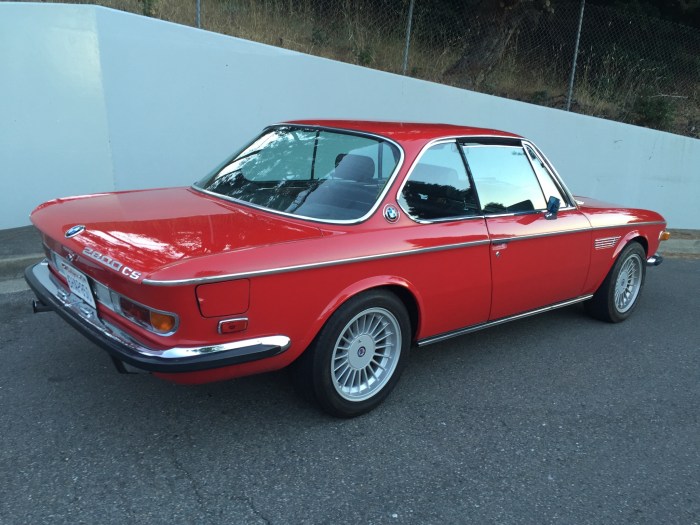
The BMW 2800CS, launched in 1971, marked a significant milestone in the German automaker’s history. It was a stylish and sophisticated grand tourer that built upon the success of its predecessor, the 2000CS, while incorporating technological advancements and refinements. The 2800CS played a crucial role in establishing BMW’s reputation for producing high-performance, luxury vehicles, solidifying its position as a major player in the global automotive market.The 2800CS was developed as a direct successor to the 2000CS, which was introduced in 1965.
The 2000CS, with its sleek coupe body and sporty handling, had already garnered considerable acclaim, but BMW recognized the need for a more powerful and refined version. The 2800CS addressed this need by incorporating a larger engine, improved suspension, and a host of other upgrades.
Development and Production History
The development of the 2800CS began in 1968, with the goal of creating a car that offered a more luxurious and powerful driving experience than the 2000CS. The engineers at BMW focused on improving the car’s performance, handling, and overall refinement.
This involved increasing the engine displacement, upgrading the suspension and brakes, and refining the interior. The car was designed by Wilhelm Hofmeister, who was responsible for the iconic “Hofmeister kink” that is still a defining characteristic of BMW’s coupe designs today.The 2800CS was officially launched in 1971, and production continued until 1975.
During this time, BMW produced over 40,000 units of the 2800CS, making it one of the most successful models in the company’s history. The car was available in a variety of markets worldwide, including Europe, North America, and Japan.
Significance in BMW’s History
The 2800CS played a significant role in establishing BMW’s reputation as a manufacturer of luxury and performance vehicles. Its combination of stylish design, powerful engine, and refined handling appealed to a wide range of buyers. The car also helped to solidify BMW’s position as a major player in the global automotive market.The 2800CS was a successful model in its own right, but it also paved the way for future BMW coupes, such as the 3.0CS and the 6 Series.
These models continued to build upon the legacy of the 2800CS, offering a combination of performance, luxury, and style that has become synonymous with the BMW brand.
Design and Engineering
The 2800CS was a stunning example of automotive design. Its sleek coupe body was characterized by its low roofline, long hood, and flowing lines. The car’s overall design was a testament to the talents of Wilhelm Hofmeister, who had a knack for creating elegant and timeless cars.Under the hood, the 2800CS was powered by a 2.8-liter inline-six engine that produced 170 horsepower.
This engine was a significant improvement over the 2.0-liter engine found in the 2000CS. The car’s suspension was also upgraded, with a new independent rear suspension that provided a more comfortable and responsive ride. The 2800CS also featured a four-wheel disc brake system, which provided excellent stopping power.
Production and Sales
The 2800CS was produced at BMW’s plant in Munich, Germany. Production began in 1971 and continued until 1975. During this time, BMW produced over 40,000 units of the 2800CS, making it one of the most successful models in the company’s history.The car was available in a variety of markets worldwide, including Europe, North America, and Japan.
It was particularly popular in Europe, where it was seen as a stylish and sophisticated alternative to other luxury coupes. The 2800CS was also well-received in North America, where it was praised for its performance and handling.
Anecdotes and Stories
One interesting anecdote about the 2800CS is that it was one of the first BMW models to feature a “Hofmeister kink” in its rear window. This design element, which was first introduced on the 1500, has since become a defining characteristic of BMW coupes.Another interesting story is that the 2800CS was used as a police car in some European countries.
This was due to the car’s powerful engine and excellent handling, which made it ideal for high-speed pursuits.
Legacy
The BMW 2800CS left a lasting legacy on the automotive world. It was a stylish and sophisticated grand tourer that helped to establish BMW’s reputation as a manufacturer of luxury and performance vehicles. The car’s design, engineering, and performance were all ahead of their time, and it continues to be admired by enthusiasts today.
Design and Styling
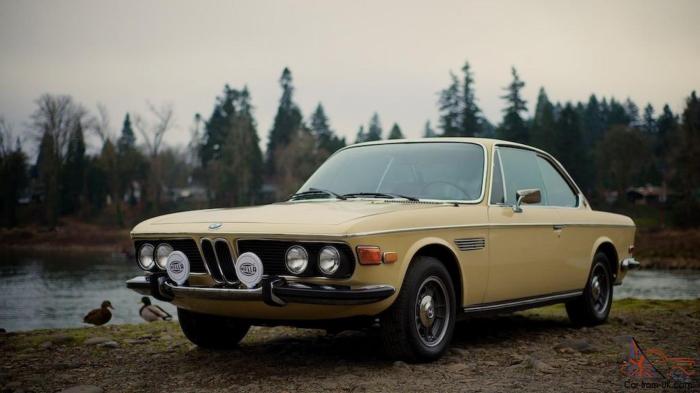
The 1971 BMW 2800CS, a true icon of its era, exemplified the harmonious blend of elegance and performance that defined the German automotive industry. Its design, a testament to the brand’s enduring legacy, embodied the timeless appeal of classic sports coupes.
Exterior Design
The 2800CS’s exterior design was characterized by its sleek and graceful lines, embodying a sense of motion even when stationary. The car’s low-slung profile, with its distinctive long hood and short rear deck, emphasized its sporty nature. The prominent front grille, adorned with the iconic BMW roundel, served as a focal point, while the sharp, angular headlights accentuated the car’s assertive stance.
The bodywork, crafted from steel, exhibited a smooth and flowing aesthetic, with minimal ornamentation. The car’s overall proportions were carefully balanced, achieving a sense of visual harmony that reflected its refined nature.
Interior Design
The interior of the 2800CS was designed to provide a luxurious and driver-focused experience. The cabin featured high-quality materials, such as leather upholstery, wood trim, and chrome accents. The dashboard, with its clean and uncluttered layout, was both functional and aesthetically pleasing.
The instrument panel, featuring large, easily readable gauges, provided the driver with essential information at a glance. The seats, designed for both comfort and support, were contoured to provide a secure and enjoyable driving experience. The overall ambiance of the interior was one of understated elegance, reflecting the car’s sophisticated nature.
The 1971 BMW 2800CS, a grand touring coupe with a sleek design and powerful engine, offered a different experience than its smaller sibling, the 1973 BMW 2002. While the 2002 focused on sporty handling and nimble performance, the 2800CS prioritized comfort and luxurious cruising, embodying the spirit of a sophisticated European getaway.
Engine and Performance
The 1971 BMW 2800CS was powered by a robust and refined engine that delivered a balance of performance and refinement, making it a compelling choice for discerning drivers of the era.
Engine Specifications
The 2800CS featured a 2.8-liter inline-six engine, designated as the M30, which was a cornerstone of BMW’s lineup during this period. This engine was known for its smooth and responsive nature, providing a satisfying driving experience.
- Displacement:2,788 cc (170.4 cu in)
- Power Output:170 hp (127 kW) at 5,500 rpm
- Torque:195 Nm (144 lb-ft) at 4,000 rpm
- Compression Ratio:9.0:1
- Fuel System:Twin Solex carburetors
- Cooling System:Water-cooled
Performance
The 2800CS’s performance was impressive for its time.
- Acceleration:0-60 mph in approximately 9.5 seconds
- Top Speed:125 mph (201 km/h)
The 2800CS’s handling was praised for its precision and responsiveness, making it a joy to drive on winding roads. Its relatively light weight and balanced chassis contributed to its agility.
The 1971 BMW 2800CS, with its sleek coupe design and powerful engine, represented a turning point for the German automaker. While it showcased the brand’s commitment to performance and elegance, it was the arrival of models like the 1990 BMW 325 that truly solidified BMW’s reputation for sportiness and handling.
The 325, with its refined handling and potent engine, further cemented BMW’s position as a leading force in the luxury performance market, a legacy that the 2800CS helped to build.
Comparison to Contemporary Sports Cars
The 1971 BMW 2800CS was a strong competitor in the burgeoning sports car market of the early 1970s. Its performance was comparable to other popular models of the time, such as the Porsche 911 and the Jaguar E-Type. While the Porsche 911 offered more raw power and track-focused handling, the 2800CS provided a more refined and comfortable driving experience, appealing to those seeking a balance of performance and elegance.
The Jaguar E-Type, known for its classic styling and powerful engine, was a direct rival in terms of luxury and performance, though the 2800CS offered a more modern and refined feel.
Ownership and Driving Experience: 1971 BMW 2800CS
Owning a 1971 BMW 2800CS is a unique and rewarding experience, offering a blend of classic style, engaging driving dynamics, and a touch of vintage charm. However, it’s important to understand the nuances of owning a car of this age, especially when it comes to maintenance, parts availability, and potential issues.
Maintenance and Parts Availability, 1971 BMW 2800CS
Maintaining a 1971 BMW 2800CS requires a commitment to regular servicing and a willingness to embrace the intricacies of classic car ownership. While the car’s mechanicals are generally robust, finding parts can be a challenge, particularly for specialized components.
- Regular Servicing:Routine maintenance, including oil changes, tune-ups, and brake inspections, is essential for keeping the car running smoothly.
- Parts Availability:While common parts like filters, spark plugs, and brake pads are readily available, finding specialized parts, such as body panels, interior trim, and certain engine components, may require searching through specialist suppliers or online forums.
- Specialized Mechanics:Due to the car’s age and unique features, it’s recommended to seek out mechanics experienced in working on classic BMWs.
Common Issues
While the 2800CS is a well-built car, like any classic vehicle, it can experience certain common issues:
- Electrical Problems:The car’s electrical system, with its age, can be prone to issues.
- Rust:Corrosion, especially in areas susceptible to moisture, can be a concern.
- Fuel System:The fuel system, including the carburetor and fuel lines, may require attention over time.
Driving Experience
The 1971 BMW 2800CS offers a driving experience that is both engaging and rewarding, with a focus on precision and comfort.
- Handling:The car’s independent suspension and precise steering provide a responsive and predictable handling experience, making it a joy to drive on winding roads.
- Ride Quality:The 2800CS’s suspension is tuned for a comfortable ride, effectively absorbing bumps and imperfections in the road.
- Engine and Performance:The 2.8-liter inline-six engine delivers a smooth and linear power delivery, providing ample performance for everyday driving and spirited excursions.
- Overall Feel:The car’s combination of responsive handling, comfortable ride, and smooth engine makes it a pleasure to drive, offering a distinct sense of refinement and character.
Strengths and Weaknesses
From an owner’s perspective, the 1971 BMW 2800CS has its strengths and weaknesses:
- Strengths:
- Classic Style and Design
- Engaging Driving Dynamics
- Comfortable Interior
- Reliable Engine
- Weaknesses:
- Parts Availability
- Potential for Electrical Issues
- Rust
- Higher Maintenance Costs Compared to Modern Vehicles
Legacy and Influence
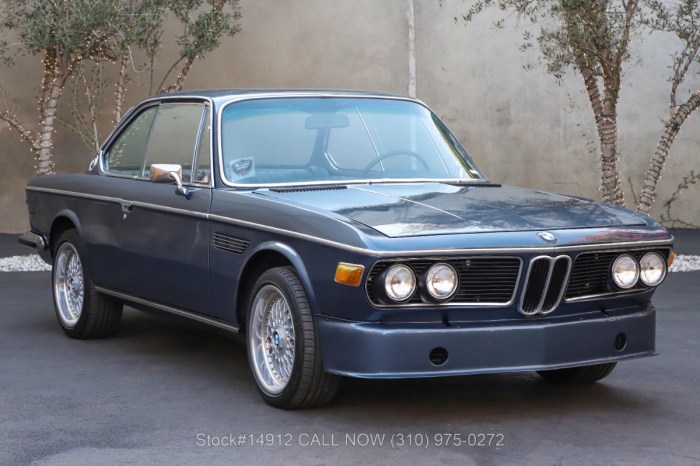
The 1971 BMW 2800CS, with its elegant design, powerful engine, and refined driving experience, left a lasting mark on the automotive industry. It was a pivotal model for BMW, cementing its reputation as a manufacturer of high-performance, stylish, and technologically advanced automobiles.
Impact on Subsequent BMW Models
The 2800CS’s influence is evident in subsequent BMW models. Its sleek coupe body style, characterized by its long hood, sloping roofline, and fastback rear, became a defining element of BMW’s design language. The 2800CS’s success paved the way for the iconic 6 Series, which further refined the coupe formula, carrying forward the spirit of the 2800CS.
The 2800CS’s engine, a 2.8-liter inline-six, was a benchmark for its smooth power delivery and refined performance. This engine, with its innovative technology and performance characteristics, laid the foundation for BMW’s renowned six-cylinder engines, which continue to power their vehicles today.
Cultural Significance
The 1971 BMW 2800CS was more than just a car; it became a symbol of style, sophistication, and performance. It was embraced by celebrities, artists, and discerning drivers worldwide, becoming a status symbol of its time. Its presence in films, television shows, and popular culture solidified its place as a cultural icon.
The 2800CS’s elegant design and luxurious interior made it a favorite among fashion designers and artists, who were drawn to its timeless aesthetics and refined craftsmanship. Its association with influential figures in the entertainment industry, such as film stars and musicians, further enhanced its cultural appeal.
Notable Examples and Variations
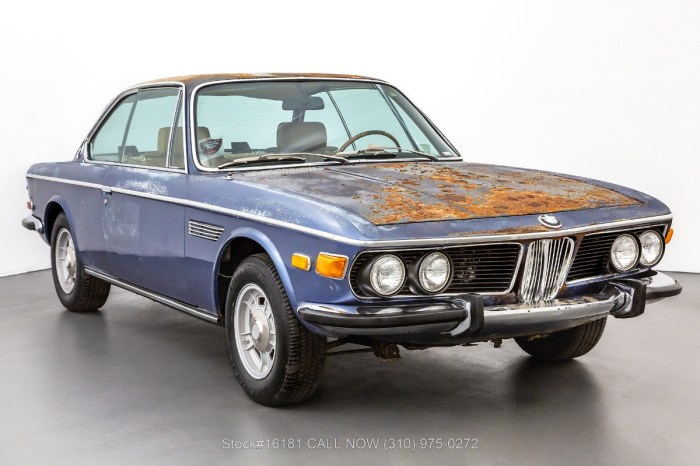
The 1971 BMW 2800CS was a highly successful model, and its production run saw a few notable examples and variations that further cemented its place in automotive history. These variations highlight the car’s evolution and the dedication of BMW to producing high-quality vehicles.
Special Editions
The 2800CS saw a few special editions, each with unique features that catered to specific markets or tastes.
- BMW 2800CS “Hommage à l’Art”: This limited edition, produced in 1972, was designed to commemorate the 50th anniversary of BMW. It featured a distinctive paint scheme, with a two-tone exterior of silver and dark blue, a special leather interior, and a commemorative plaque.
Only 100 units were produced, making it a highly sought-after collector’s item today.
- BMW 2800CS “Touring”: This version was designed for long-distance driving. It featured a larger fuel tank, improved sound insulation, and a more comfortable interior. This edition was available in a limited number of markets and was popular among those who appreciated its practicality and comfort.
Variations and Modifications
Beyond special editions, the 2800CS saw several variations and modifications throughout its production run. These changes were driven by factors such as market demand, evolving safety regulations, and technological advancements.
- Engine Upgrades: The 2800CS’s engine underwent several upgrades during its production run. Early models were equipped with a 2.8-liter inline-six engine, while later models received a 3.0-liter version. These upgrades resulted in improved performance and fuel efficiency.
- Safety Features: As safety regulations became more stringent, the 2800CS saw the introduction of new safety features, such as disc brakes on all four wheels and a stronger chassis. These improvements significantly enhanced the car’s safety and contributed to its overall appeal.
- Exterior and Interior Updates: The 2800CS also received several cosmetic updates throughout its production run. These included changes to the grille, bumpers, and taillights, as well as updates to the interior trim and upholstery. These updates helped to keep the car looking fresh and modern, ensuring its continued appeal to buyers.
Notable Examples
The 2800CS was a popular car among enthusiasts, and several notable examples have been preserved and continue to be admired today.
- The “Bavarian Bullet”: This particular 2800CS was owned by a prominent German businessman who used it for both daily driving and long-distance trips. The car was meticulously maintained and is known for its excellent condition and original paint.
- The “Race-Prepped” 2800CS: This car was originally purchased by a privateer racer who extensively modified it for competition. It featured a tuned engine, a reinforced suspension, and a lightweight body. The car competed in several races and achieved notable success in its class.
The 1971 BMW 2800CS, with its elegant coupe styling and refined performance, represented a high point in BMW’s history. While its sleek lines and driving dynamics were admired, the model was eventually overshadowed by later iterations, like the 1991 BMW 5 Series , which introduced a more modern and athletic design language.
However, the 2800CS continues to hold a special place in the hearts of enthusiasts, showcasing the brand’s early commitment to luxury and performance.
Comparison to Contemporaries
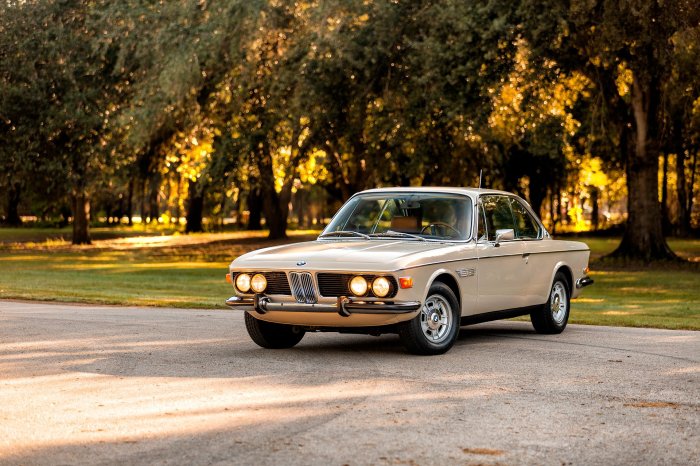
The 1971 BMW 2800CS, with its elegant design and refined performance, was a strong contender in the burgeoning luxury sports coupe market of the early 1970s. However, it faced stiff competition from established European and American manufacturers, each with their own strengths and weaknesses.
Understanding these rivals provides valuable context for assessing the 2800CS’s place in the market.
Competition and Market Positioning
The 2800CS competed directly with other grand touring coupes, including the Mercedes-Benz 280SL, the Jaguar E-Type, and the Porsche 911. The Mercedes-Benz 280SL, while known for its luxurious interior and comfort, was criticized for its comparatively sluggish performance and high price.
The Jaguar E-Type, with its iconic design and powerful engine, offered thrilling performance but suffered from reliability issues and dated interior. The Porsche 911, while renowned for its handling and performance, was often considered too spartan and expensive for everyday use.
- The 2800CS offered a compelling balance between performance, luxury, and practicality. Its 2.8-liter inline-six engine, while not as powerful as the Jaguar E-Type, provided ample power for spirited driving. Its refined interior and comfortable ride were a clear advantage over the Porsche 911.
The 2800CS’s reputation for reliability also positioned it favorably against the Jaguar E-Type.
- The 2800CS’s target audience was discerning drivers seeking a sophisticated and capable coupe. It appealed to those who desired the prestige of a European luxury car without sacrificing performance. The 2800CS’s blend of sportiness and elegance made it a popular choice among professionals, entrepreneurs, and those seeking a stylish and refined driving experience.
Factors Contributing to Success
The 2800CS’s success was attributed to several key factors:
- Strong Brand Reputation:BMW had established a reputation for building high-quality, performance-oriented automobiles. The 2800CS benefitted from this brand recognition, attracting buyers seeking a reliable and well-engineered car.
- Balanced Performance and Luxury:The 2800CS successfully balanced performance with luxury. Its 2.8-liter engine offered ample power for spirited driving, while its comfortable interior and refined ride provided a luxurious experience.
- Stylish Design:The 2800CS’s elegant design, with its long hood, flowing lines, and distinctive Hofmeister kink, was a key attraction. Its sleek and sophisticated appearance helped it stand out in a crowded market.
- Reputation for Reliability:Compared to its competitors, the 2800CS was known for its reliability. This was a significant factor for buyers seeking a car that could be enjoyed without constant worry about breakdowns.
Technical Specifications and Data
The 1971 BMW 2800CS, a symbol of elegance and performance, was meticulously engineered to deliver a refined driving experience. Its technical specifications showcase a blend of advanced technology and classic design, solidifying its place as a notable automotive achievement.
Technical Specifications
The technical specifications of the 1971 BMW 2800CS highlight its key features and capabilities.
| Specification | Value |
|---|---|
| Engine | 2.8-liter inline-six, M30 |
| Horsepower | 170 hp (125 kW) at 5,500 rpm |
| Torque | 180 lb-ft (245 Nm) at 4,000 rpm |
| Transmission | 4-speed manual or 3-speed automatic |
| Weight | 2,822 lbs (1,280 kg) |
| Length | 173.2 inches (4,399 mm) |
| Width | 66.5 inches (1,690 mm) |
| Height | 52.4 inches (1,331 mm) |
| Wheelbase | 102.4 inches (2,601 mm) |
| Fuel Economy | 18 mpg (city), 25 mpg (highway) (estimated) |
Engine and Performance
The 1971 BMW 2800CS was powered by a 2.8-liter inline-six engine, known as the M30. This engine was a marvel of engineering, delivering smooth power and a refined driving experience. The engine produced 170 horsepower and 180 lb-ft of torque, enabling the car to accelerate from 0 to 60 mph in approximately 9.5 seconds.
The 2800CS’s engine was known for its smooth and responsive nature, providing a balance of power and efficiency.
Dimensions and Weight
The 1971 BMW 2800CS was a mid-size coupe, with dimensions that reflected its elegant and sporty design. It measured 173.2 inches in length, 66.5 inches in width, and 52.4 inches in height, with a wheelbase of 102.4 inches. The car’s weight was approximately 2,822 lbs.
Fuel Economy
The 1971 BMW 2800CS was designed to deliver respectable fuel economy for its time. It achieved an estimated 18 mpg in city driving and 25 mpg on the highway.
Images and Visuals
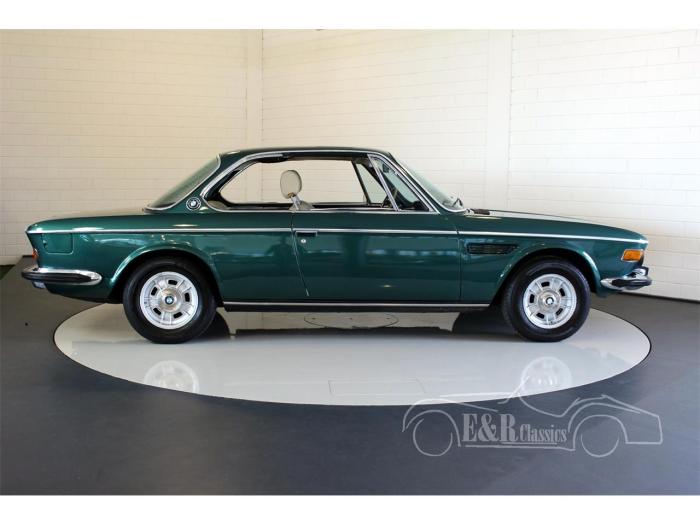
The 1971 BMW 2800CS, a timeless classic, is a visual feast for car enthusiasts. Its sleek lines, elegant proportions, and intricate details make it a captivating subject for photography. These images capture the essence of the car, showcasing its iconic design and highlighting its key features.
Gallery of Images
The following images provide a comprehensive visual tour of the 1971 BMW 2800CS. Each image offers a unique perspective, highlighting specific design elements and features.
- Front View:The 2800CS’s front end is defined by its distinctive kidney grille, flanked by two round headlights. The long, sloping hood and the low-slung stance convey a sense of power and athleticism. The chrome bumpers and trim add a touch of elegance, complementing the car’s overall sophistication.
- Side View:The profile of the 2800CS is characterized by its long, flowing lines and a gently sloping roofline. The sharp crease running along the side of the body, from the front fender to the rear, adds a dynamic element to the design.
The chrome window surrounds and door handles enhance the car’s overall elegance.
- Rear View:The rear of the 2800CS is equally striking, with its integrated taillights and a distinctive rear bumper. The sloping rear window and the low-mounted license plate contribute to the car’s sporty appearance. The dual exhaust pipes, visible beneath the bumper, hint at the car’s performance potential.
- Interior View:The interior of the 2800CS is a testament to German engineering and craftsmanship. The dashboard is uncluttered and driver-focused, with a simple yet elegant layout. The leather upholstery, wood trim, and chrome accents create a luxurious and inviting atmosphere.
- Engine Bay:The 2800CS’s engine bay showcases the car’s mechanical prowess. The 2.8-liter straight-six engine is a masterpiece of engineering, with its smooth operation and impressive power output. The clean and organized layout of the engine bay reflects the meticulous attention to detail that defines BMW’s engineering philosophy.
Conclusive Thoughts
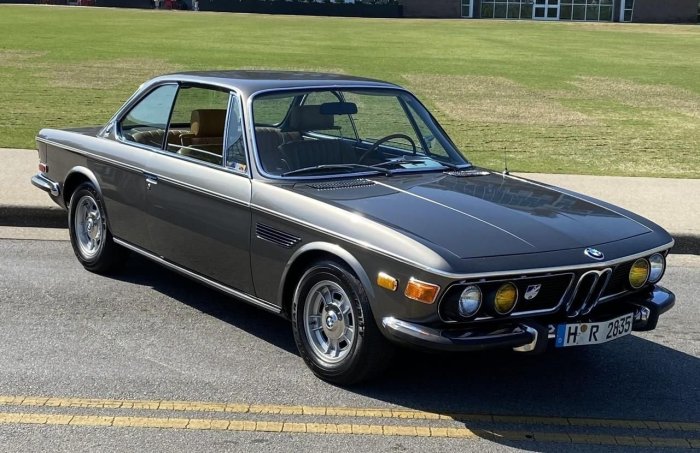
The 1971 BMW 2800CS remains a highly sought-after classic, appreciated for its timeless design, refined performance, and enduring legacy. Today, it continues to captivate enthusiasts with its combination of elegance and driving pleasure, reminding us of a bygone era when automotive engineering and design were inextricably intertwined.
The 2800CS’s influence can be seen in subsequent BMW models, particularly the 6 Series, which inherited its graceful lines and sporty character. As a testament to its enduring appeal, the 2800CS continues to hold a special place in the hearts of automotive enthusiasts and collectors, serving as a symbol of BMW’s commitment to building exceptional automobiles.